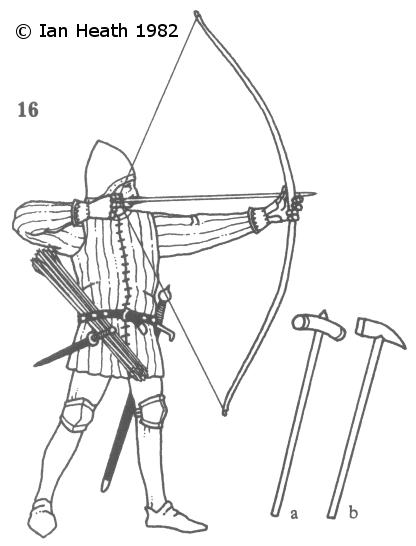
Register a SNAP EBT card with Amazon
ENGLISH ARCHER c.1398
An extract from Armies of the Middle Ages, Volume 1by Ian Heath



16. ENGLISH ARCHER c.1398
This figure comes from a Hundred Years’ War battle-scene in a French ms., an edition of the ‘Grandes Chroniques de France’ from which illustrations are widely reproduced in modern works. He wears an aketon, a bascinet, poleyns and, surprisingly, iron gauntlets (though it is known that leather gauntlets were indeed often worn on the right hand by archers). Chaucer’s Yeoman-archer also belongs to this period, the Canterbury Tales having been written c. 1386-1400. He is described as wearing a green coat and hood, with a ‘mighty’ bow, a sheaf of peacock-feathered arrows under his belt, a sword and buckler at his left and a long knife at his right, and a bracer on his left forearm. Incidentally, Chaucer’s description of this character as a forester is a pun, forestiere being 14th century colloquial Italian for a foreign mercenary!
The Sire de St Remy, a participant on the English side at the Battle of Agincourt, describes the English archers on that occasion as ‘for the most part without armour except their pourpoints; their stockings rolled down to the knees, and having hatchets (probably mauls) and battle-axes hanging at their waists, or long swords, some barefooted and bareheaded, others with huvettes or capelinas (helmets) of cuir-bouilli, and others of osier, strengthened with a cross-band of iron’. Another eye-witness describes them getting stuck in with swords, hatchets, mauls, axes, becs de faucon ‘and other weapons’. Of all these secondary weapons it seems to have been the leaden-headed maul, or hammer, that took pride of place, so much so that in the 16th century Ascham looked upon it as absolutely typical of an archer’s equipment, ‘either at his backe hangyng, or els in his next felous hande’. Froissart describes mauls under the year 1381 as ‘mallets of iron and steel, perilous staves to destroy helms and bascinets’. Two 14th century examples of mauls are depicted in 16a and b.
Interestingly writs of Edward III’s reign record swords, daggers and even spears as secondary weapons for archers, but they do not once mention mauls.